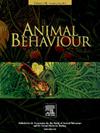Predation risk creates unexpected migration decisions in a nonhoming semelparous fish
IF 2.3
2区 生物学
Q2 BEHAVIORAL SCIENCES
引用次数: 0
Abstract
Predation risk and migration are major forces shaping animal behaviour and fitness. Migratory animals are often under incredible energy and time constraints, yet predation risk is present during many natural migrations. Manipulating risk landscapes of migrating animals in natural settings offers an especially powerful way to assess how the perception of multiple chemical cues across large scales affects migratory behaviour and decision-making processes. In this study, we presented 432 upstream migrating sea lamprey, Petromyzon marinus (a nonhoming semelparous fish) with a choice between two streams that differed in the presence or absence of an alarm cue, while chemical cues associated with suitable breeding conditions were present in each stream (larvae from previous generations). Three-quarters of them were detected at the confluence 3.3 km upstream on their night of release and during alarm cue exposure hours. Sea lamprey preferred the warmer of the two stream branches upstream of the confluence on nights when alarm cue was absent. Unexpectedly, the presence of alarm cue in either stream branch led to a preference for the branch upstream of the deeper portion of the main channel, independent of temperature differences between the streams. These results demonstrate that migratory decisions by sea lamprey at key points in their migration can be altered by the presence of predation risk. However, physical stream properties such as depth can potentially alter the perceived risk of predation and antipredator responses.
求助全文
约1分钟内获得全文
求助全文
来源期刊

Animal Behaviour
生物-动物学
CiteScore
4.60
自引率
8.00%
发文量
236
审稿时长
10.2 weeks
期刊介绍:
Growing interest in behavioural biology and the international reputation of Animal Behaviour prompted an expansion to monthly publication in 1989. Animal Behaviour continues to be the journal of choice for biologists, ethologists, psychologists, physiologists, and veterinarians with an interest in the subject.
 求助内容:
求助内容: 应助结果提醒方式:
应助结果提醒方式:


